Railroad bus
The rail-road bus, also called Schi-Stra-Bus for short, is a two-way vehicle for passenger traffic on railway lines and roads. The Deutsche Bundesbahn (DB) used it both as a local train and as a train bus.
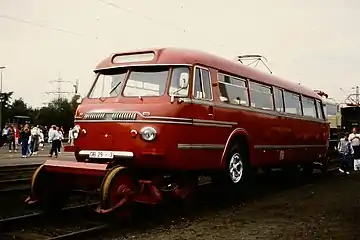
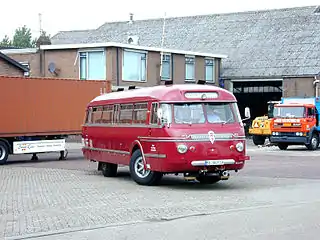

The vehicle
The vehicle is a special omnibus with all the facilities necessary for road traffic. The rail road bus was equipped with a diesel engine from Klöckner-Humboldt-Deutz from the bus construction. This had an output of 88 kilowatts (118 hp), it allowed a speed of 80 km/h (50 mph) on the road and 120 km/h (75 mph) on rails. The vehicles had 43 seats and 15 to 24 standing places.
The car was a one-way vehicle, but was equipped according to the regulations for rail traffic. So it had doors on both sides, had a train-compatible brake that acted on the track wagons, a safety drive circuit and an emergency braking device. For operation on railroad tracks, the bus was placed on two two-axle bases - called "track wagons". For this purpose, the rail-road bus had two hydraulic lifting devices, with which the front and rear vehicle halves were alternately lifted for putting on and taking off the track wagons. In front of the front axle and behind the rear axle was a bearing for the Trolley pivot. A grooved track at street level was required for the positioning. The front axle was completely raised in rail mode, the tires of the rear wheels were seated on the rails and provided the drive. During the change to and from the track wagons, the passengers stayed on the bus.[1]
Procurement
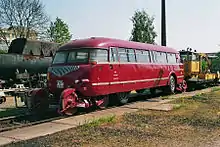
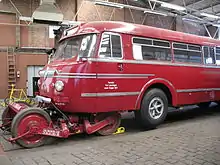
In 1951, the Deutsche Bundesbahn ordered two prototypes from the Nordwestdeutscher Fahrzeugbau company in Wilhelmshaven. The track wagons were manufactured by Waggon- und Maschinenbau GmbH Donauwörth. The prototypes were delivered and tested in 1952. Shortly afterwards three series vehicles followed, one was presented in March 1953 at the International Motor Show in Frankfurt am Main. In 1953 another 50 vehicles were ordered. In total, however, only 15 wagons were used on the rails, the rest ran as pure road vehicles.
Use
Passau – Wegscheid
On the railway line Passau-Wegscheid, the two rack portions included, found in 1951 [Anm. 1] test drives instead. The rail-road bus also managed these steep sections. Because of the snow in winter, year-round operation seemed out of the question.[2]
Passau – Cham
The first three series vehicles were at the beginning of the summer schedule as of 12 June 1953[2] on the route from Passau to Cham used:
- Passau– Grafenau : street
- Grafenau– Bodenmais : 46.0 km of rail on the Grafenau – Zwiesel and Zwiesel – Bodenmais railway lines
- Bodenmais– Kötzting : street
- Kötzting – Cham: 17.8 km of rail on the Cham – Lam railway line
Of the 140.7 km total distance [Anm. 2] 63.8 were thus covered on rails. Ten minutes each were planned for moving from rail to road and vice versa. In addition, the direction of travel was changed at Zwiesel station. The total travel time was five and a half hours. The connection was offered once a day. Because there was no storage facility in Cham, the connection was later extended by 19.2 km to Furth im Wald using the Schwandorf – Furth im Wald railway line.[3] To this end, a further change of direction in Cham was required.
The connection in the Bavarian Forest existed until June 1, 1957[2] and was abandoned mainly because of the traction problems that occurred in winter. It was the only one of the connections with the rail-road bus that received its own timetable table in the course book of the Deutsche Bundesbahn under number 426h and was therefore also marked with a special signature on the attached map.[4]
Augsburg – Füssen
From 1954 to 1958, the Augsburg - Füssen connection was operated once a day. It ran from Augsburg on the road to Pforzen, then on the track via the Allgäu Railway, the Biessenhofen – Füssen railway and the Marktoberdorf – Lechbruck railway to Roßhaupten. From there we continued on the road to Füssen.[4] In the course book she was led under the number 406c. The journey took three hours and ten minutes.
Koblenz – Betzdorf
The Koblenz - Betzdorf link was established for the 1954/55 winter timetable. The route ran from Koblenz on the road to Dierdorf and from there over the railway line Engers-Au to Au (Sieg) and further on the Siegbahn to Betzdorf. It proved to be the greatest success of this concept and therefore lasted the longest. The number of seats was often not sufficient for the number of people willing to travel.[5] A trip took two and a half hours. This was the only connection that offered two trips per day and direction. The last scheduled trip on May 27, 1967 sealed the end of the rail-road bus.[1]
Wutach Valley Railway
The Wutach Valley Railway was built for military strategic reasons. The middle section between Weizen and Blumberg covered a distance of 9.6 km as the crow flies with a railway line of 24.7 km in length due to inclines. As expected during construction, the operating result was strongly negative, since the prices of the tickets were based on the route length, not on the airline distance. Traffic on the street was faster and cheaper. In the post-war period, when the military strategic importance of the route no longer existed, rail traffic was discontinued in the middle section in 1955, but the further sections in the north and south continued to be served by rail traffic, which caused two changes in theStation wheat and the train station Blumberg-Zollhaus meant. These transfers were to be spared for passengers, which is why the Deutsche Bundesbahn used the Schi-Stra bus on the parallel federal road 314. However, the experience with the two-way vehicle was so bad that its use ended when the timetable changed in December 1955.[6]
Further missions
There were other, only short, operations, for example from Bernkastel to Remagen, via the Black Forest Railway (Baden) to Immendingen or between May 1953 and November 1955 from Waldshut via the Hochrheinbahn.
Remaining vehicle
A vehicle with two track wagons is owned by the Bochum Railway Museum Foundation and is exhibited in its Railway Museum. This vehicle is operational. However, the approval of the Federal Railway Authority limits its use today: tunnel passages and oncoming traffic on multi-track routes are not permitted.[7] The reaction between road and rail is sometimes presented in larger venues.
Other
When the computer-readable vehicle numbers were introduced on January 1, 1968, the series number 790 was still assigned for the rail-road bus, but all vehicles had already been retired by the cut-off date.
Cars similar to other tracks
France
In the early 1940s, the engineer Talon developed a system in which a normal street bus ran on rails and was able to pull a light " Decauville " railcar sidecar. The bus drove over a special ramp to two track wagons, after which the front wheels no longer touched the rails, but the inside of the rear double wheels remained in contact with the track. At least one of these vehicles powered by wood gas was used in the summer of 1943 on the 54 km long railway line of the Carcassonnaise de Transports en Commun (CCTC)[8] from Carcassonne to Quillan.[9]
Japan
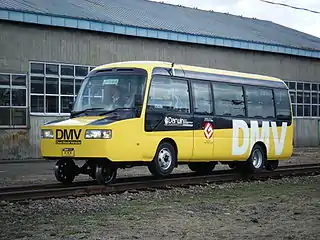
Rail-road buses were also developed in Japan, by JR Hokkaido in 2002, under the name “DMV” (Dual Mode Vehicle).[10] The DMV920 model no longer used external bogies, the two axles that are carried along are only lowered on the single rail.
History
A test vehicle (DMV901) began trials in January 2004 and DMV911/912 began in September 2005. Further testing began 4 April 2007, on the Senmo Line between Mokoto and Hamakoshimizu. One leg is from Hamakoshimizu to Mokoto (about 11 km) as a rail trip and Mokoto to Hamakoshimizu as a passenger bus (about 25 km). DMV920 was completed in June 2008 with a capacity of 28 passengers.[11]
Netherlands
In the Netherlands a Michelin car was tried in 1932.
United States
Such a system was experimented with in the United States in the second half of the 1960s. Two Red Arrow Lines diesel buses were converted so that they could also run on rails.[12]
References
- Nagel.
- Bufe, S. 27.
- "Eisenbahnen im W e s t e r w a l d - Einsätze im Westerwald und in anderen Gebieten". www.westerwaelder-bahnen.net.
- Angaben gemäß amtlichem Kursbuch der Deutschen Bundesbahn vom Sommer 1955.
- Zu dieser Verbindung insbesondere: Strack, Seiten 200f.
- Schi-Stra-Bus im Einsatz auf der Wutachtalbahn.
- Tomas Meyer-Eppler: Der Schie–Stra–Bus fährt wieder. In: Lok Magazin 3/2002, S. 22.
- L’étonnant autorail-bus de l’Aude bei grandsudinsolite.fr, abgerufen am 6. Januar 2018
- Clive Lamming (2006), Trains de Légende: Les Réseaux français et la Naissance de la SNCF (1938–1950) (in German), p. 105, ISBN 2-8302-2147-8
- "編集長敬白アーカイブ|鉄道ホビダス". rail.hobidas.com.
- Japan Railway & Transport Review No. 51. pp. 28–39. Retrieved 2020-08-25.
- The Trolley Dodger bei thetrolleydodger.com, abgerufen am 6. Mai 2020
Notes
- So: Bufe, S. 27. Da die Fahrzeuge aber erst 1952 geliefert wurden, muss es wahrscheinlich „1952“ heißen.
- So: Amtliches Kursbuch der Deutschen Bundesbahn vom Sommer 1955; Bufe, S. 27, nennt 142,7 km.
- Sun: Bufe, p. 27. Since the vehicles were only delivered in 1952, it probably has to read "1952".
- Sun: Official course book of the Deutsche Bundesbahn from summer 1955; Bufe, p. 27, mentions 142.7 km.
Further reading
Sorted alphabetically by authors / editors
- Siegfried Bufe: Wege nach Passau. In: Eisenbahn Geschichte 93 (2019), pp. 12–27.
- Gustav Nagel: Auf Gummi und Stahl. In: Lok Magazin. 41. Jahrgang, Nr. 250 7/(2002). ISSN 0458-1822, pp. 52–53.
- Wolfgang Stoffels: Die Schienen-Straßen-Omnibusse. Deutsche Gesellschaft für Eisenbahngeschichte Folge 25 (1980). ISBN 3-921700-31-0.
- Klaus Strack: 150 Jahre Eisenbahn im Siegtal. Nümbrecht 2010. ISBN 978-3-89909-100-7.
External links
| Wikimedia Commons has media related to Schienen-Straßen-Omnibus. |
- Der Schienen-Straßen-Omnibus auf www.westerwaelder-bahnen.net
- Der Schienen-Straßen-Omnibus zwischen Betzdorf und Koblenz (1958)
- L’étonnant autorail-bus de l’Aude (französisch) mit Foto des Talon bus
- The rail road bus on The rail road bus between Betzdorf and Koblenz (1958)